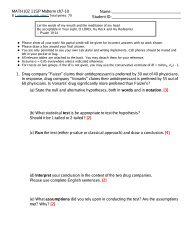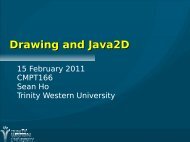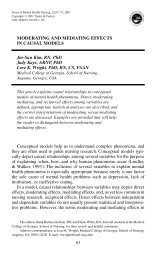Linear Regression
Linear Regression
Linear Regression
You also want an ePaper? Increase the reach of your titles
YUMPU automatically turns print PDFs into web optimized ePapers that Google loves.
<strong>Linear</strong> <strong>Regression</strong><br />
2 Oct 2009<br />
CPSY501<br />
Dr. Sean Ho<br />
Trinity Western University<br />
Please download from<br />
“Example Datasets”:<br />
● Record2.sav<br />
● ExamAnxiety.sav
Outline for today<br />
Correlation and Partial Correlation<br />
<strong>Linear</strong> <strong>Regression</strong> (Ordinary Least Squares)<br />
● Using <strong>Regression</strong> in Data Analysis<br />
● Requirements: Variables<br />
● Requirements: Sample Size<br />
Assignments & Projects<br />
CPSY501: multiple regression 2 Oct 2009<br />
2
Causation from correlation?<br />
Ancient proverb: “correlation ≠ causation”<br />
But: sometimes correlation can suggest<br />
causality, in the right situations!<br />
● Need >2 variables, and it's<br />
● Not the “ultimate” (only, direct) cause, but<br />
● Degree of influence one var has on another<br />
(“causal relationship”, “causality”)<br />
Is a significant fraction of the variability in one<br />
variable explained by the other variable(s)?<br />
CPSY501: multiple regression 2 Oct 2009<br />
3
How to get causality?<br />
Use theory and prior empirical evidence<br />
● e.g., temporal sequencing: can't be T2 → T1<br />
● Order of causation? (gender & career aspir.)<br />
Best is a controlled experiment:<br />
● Randomly assign participants to groups<br />
● Change the level of the IV for each group<br />
● Observe impact on DV<br />
But this is not always feasible/ethical!<br />
Still need to “rule out” other potential factors<br />
CPSY501: multiple regression 2 Oct 2009<br />
4
Potential hidden factors<br />
What other vars might explain these correlatns?<br />
● Height and hair length<br />
e.g., both are related to gender<br />
● Increased time in bed and suicidal thoughts<br />
e.g., depression can cause both<br />
● # of pastors and # of prostitutes (!)<br />
e.g., city size<br />
To find causality, must rule out hidden factors<br />
e.g., cigarettes and lung cancer<br />
CPSY501: multiple regression 2 Oct 2009<br />
5
Example: immigration study<br />
Psych.<br />
Well-being<br />
Level of<br />
Acculturation<br />
?<br />
Psychological<br />
Well-being<br />
Linguistic<br />
Ability<br />
Immigration<br />
1 Year<br />
Linguistic<br />
Ability<br />
Follow-up<br />
CPSY501: multiple regression 2 Oct 2009<br />
6
Partial Correlation<br />
Purpose: to measure the unique relationship<br />
between two variables – after the effects of<br />
other variables are “controlled for”.<br />
Two variables may have a large correlation, but<br />
● It may be largely due to the effects of other<br />
moderating variables<br />
● So we must factor out their influence, and<br />
● See what correlation remains (partial)<br />
SPSS algorithm assumes parametricity<br />
● There exist non-parametric methods, though<br />
CPSY501: multiple regression 2 Oct 2009<br />
7
Visualizing Partial Correlation<br />
Variable 1<br />
(e.g., pastors)<br />
Direction<br />
of Causation?<br />
?<br />
Variable 2<br />
(e.g., prostitutes)<br />
Moderating Variable<br />
(e.g., city size)<br />
Partial<br />
Correlation<br />
CPSY501: multiple regression 2 Oct 2009<br />
8
Practise: Partial Correlation<br />
Dataset: Record2.sav<br />
Analyze → Correlate → Partial,<br />
● Variables: adverts, sales<br />
● Controlling for: airplay, attract<br />
Or: Analyze → <strong>Regression</strong> → <strong>Linear</strong>:<br />
● Dependent: sales; Independents: all other var<br />
● Statistics → “Part and partial correlations”<br />
Uncheck everything else<br />
● All partial r, plus regular (0-order) r<br />
CPSY501: multiple regression 2 Oct 2009<br />
9
<strong>Linear</strong> <strong>Regression</strong><br />
When we use correlation to try to infer<br />
direction of causation, we call it regression:<br />
Combining the influence of a number of<br />
variables (predictors) to determine their<br />
total effect on another variable (outcome).<br />
OLS <strong>Regression</strong><br />
CPSY501: multiple regression 2 Oct 2009<br />
10
Simple <strong>Regression</strong>: 1 predictor<br />
Simple regression is predicting scores on an<br />
outcome variable from a single predictor variable<br />
Mathematically equiv. to bivariate correlation<br />
<strong>Regression</strong><br />
CPSY501: multiple regression 2 Oct 2009<br />
11
OLS <strong>Regression</strong> Model<br />
In Ordinary Least-Squares (OLS) regression,<br />
the “best” model is defined as the line that<br />
minimizes the error between model and data<br />
(sum of squared differences).<br />
Conceptual description of regression line<br />
(General <strong>Linear</strong> Model):<br />
Y = b 0<br />
+ b 1<br />
X 1<br />
+ (B 2<br />
X 2<br />
… + B n<br />
X n<br />
) + ε<br />
Outcome Gradient<br />
Intercept<br />
Predictor<br />
Error<br />
CPSY501: multiple regression 2 Oct 2009<br />
12
Assessing Fit of a Model<br />
R 2 : proportion of variance in outcome<br />
accounted for by predictors: SS model<br />
/ SS tot<br />
● Generalization of r 2 from correlation<br />
F ratio: variance attributable to the model<br />
divided by variance unexplained by model<br />
● F ratio converts to a p-value,<br />
which shows whether the “fit” is good<br />
If fit is poor, predictors may not be linearly<br />
related to the outcome variable<br />
CPSY501: multiple regression 2 Oct 2009<br />
13
Example: Record Sales<br />
Dataset: Record2.sav<br />
Outcome variable: Record sales<br />
Predictor: Advertising Budget<br />
Analyze → <strong>Regression</strong> → <strong>Linear</strong><br />
● Dependent: sales; Independent: adverts<br />
● Statistics → Estimates, Model fit,<br />
Part and partial correlations<br />
CPSY501: multiple regression 2 Oct 2009<br />
14
Example: Interpreting Results<br />
Model Summary: R Square = .335<br />
● adverts explains 33.5% of variability in sales<br />
ANOVA: F = 99.587 and Sig. = .000<br />
● There is a significant effect<br />
Report: R 2 = .335, F(1, 198) = 99.587, p < .001<br />
Coefficients: (Constant) B = 134.140 (Y-intcpt)<br />
● Unstandardized advert B = .096 (slope)<br />
● Standardized advert Beta = .578<br />
(with all variables converted to z-scores)<br />
● <strong>Linear</strong> model: Ŷ = .578 * AB z<br />
+ 134<br />
CPSY501: multiple regression 2 Oct 2009<br />
15
CPSY501: multiple regression 2 Oct 2009<br />
16
General <strong>Linear</strong> Model<br />
Actually, nearly all parametric methods can be<br />
expressed as generalizations of regression!<br />
Multiple <strong>Regression</strong>: several scale predictors<br />
Logistic <strong>Regression</strong>: categorical outcome<br />
ANOVA: categorical IV<br />
● t-test: dichotomous IV<br />
● ANCOVA: mix of categorical + scale IVs<br />
● Factorial ANOVA: several categorical IVs<br />
Log-linear: categorical IVs and DV<br />
We'll talk about each of these in detail later<br />
CPSY501: multiple regression 2 Oct 2009<br />
17
<strong>Regression</strong> Modelling Process<br />
(1) Develop RQ: IVs/DVs, metrics<br />
● Calc required sample size & collect data<br />
(2) Clean: data entry errors, missing data, outliers<br />
(3) Explore: assess requirements, xform if needed<br />
(4) Build model: try several models, see what fits<br />
(5) Test model: “diagnostic” issues:<br />
● Multivariate outliers, overly influential cases<br />
(6) Test model: “generalizability” issues:<br />
● <strong>Regression</strong> assumptions: rebuild model<br />
CPSY501: multiple regression 2 Oct 2009<br />
18
Selecting Variables<br />
According to your model or theory, what<br />
variables might relate to your outcomes?<br />
● Does the literature suggest important vars?<br />
Do the variables meet all the requirements for<br />
an OLS multiple regression?<br />
● (more on this next week)<br />
Record sales example:<br />
● DV: what is a possible outcome variable?<br />
● IV: what are possible predictors, and why?<br />
CPSY501: multiple regression 2 Oct 2009<br />
19
Choosing Good Predictors<br />
It's tempting to just throw in hundreds of<br />
predictors and see which ones contribute most<br />
● Don't do this! There are requirements on<br />
how the predictors interact with each other!<br />
● Also, more predictors → less power<br />
Have a theoretical/prior justification for them<br />
Example: what's a DV you are interested in?<br />
● Come up with as many possible good IVs as<br />
you can – have a justification!<br />
Background, internal personal,<br />
current external environment<br />
CPSY501: multiple regression 2 Oct 2009<br />
20
Using Derived Variables<br />
You may want to use derived variables in<br />
regression, for example:<br />
Transformed variables (to satisfy assumptions)<br />
Interaction terms: (“moderating” variables)<br />
● e.g., Airplay * Advertising Budget<br />
Dummy variables:<br />
● e.g., coding for categorical predictors<br />
Curvilinear variables (non-linear regression)<br />
● e.g., looking at X 2 instead of X<br />
CPSY501: multiple regression 2 Oct 2009<br />
21
Required Sample Size<br />
Depends on effect size and # of predictors<br />
● Use G*Power to find exact sample size<br />
● Rough estimates on pp. 172-174 of Field<br />
Consequences of insufficient sample size:<br />
● <strong>Regression</strong> model may be overly influenced<br />
by individual participants (not generalizable)<br />
● Can't detect “real” effects of moderate size<br />
Solutions:<br />
● Collect more data from more participants!<br />
● Reduce number of predictors in the model<br />
CPSY501: multiple regression 2 Oct 2009<br />
22
Requirements on DV<br />
Must be interval/continuous:<br />
● If not: mathematics simply will not work<br />
● Solutions:<br />
Categorical DV: use Logistic <strong>Regression</strong><br />
Ordinal DV: use Ordinal <strong>Regression</strong>,<br />
or possibly convert into categorical form<br />
Independence of scores (research design)<br />
● If not: invalid conclusions<br />
● Solutions: redesign data set, or<br />
Multi-level modelling instead of regression<br />
CPSY501: multiple regression 2 Oct 2009<br />
23
Requirements on DV, cont.<br />
Normal (use normality tests):<br />
● If not: significance tests may be misleading<br />
● Solutions: Check for outliers, transform data,<br />
use caution in interpreting significance<br />
Unbounded distribution (obtained range of<br />
responses versus possible range of responses)<br />
● If not: artificially deflated R 2<br />
● Solutions:<br />
Collect more data from missing range<br />
Use a more sensitive instrument<br />
CPSY501: multiple regression 2 Oct 2009<br />
24
Requirements on IV<br />
Scale-level<br />
● Can be categorical, too (see next page)<br />
● If ordinal, either threshold into categorical or<br />
treat as if scale (only if have sufficient<br />
number of ranks)<br />
Full-range of values<br />
● If an IV only covers 1-3 on a scale of 1-10,<br />
then the regression model will predict poorly<br />
for values beyond 3<br />
More requirements on the behaviour of IVs with<br />
each other and the DV (covered next week)<br />
CPSY501: multiple regression 2 Oct 2009<br />
25
Categorical Predictors<br />
<strong>Regression</strong> can work for categorical predictors:<br />
If dichotomous: code as 0 and 1<br />
● e.g., 1 dichotomous predictor, 1 scale DV:<br />
● <strong>Regression</strong> is equivalent to t-test!<br />
● And the slope B 1<br />
is the difference of means<br />
If n categories: use “dummy” variables<br />
● Choose a base category<br />
● Create n-1 dichotomous variables<br />
● e.g., {BC, AB, SK}: dummys are isAB, isSK<br />
CPSY501: multiple regression 2 Oct 2009<br />
26

















